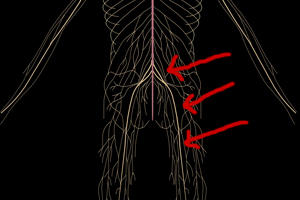 Often misunderstood to be a diagnosis, sciatica is actually the term for a collection of symptoms, the most pronounced of which is low back pain combined with pain that extends through the buttocks and down one leg. It is one of the most common forms of low back pain and, as such, is regularly treated by chiropractors.
Often misunderstood to be a diagnosis, sciatica is actually the term for a collection of symptoms, the most pronounced of which is low back pain combined with pain that extends through the buttocks and down one leg. It is one of the most common forms of low back pain and, as such, is regularly treated by chiropractors.
Sciatica takes its name from the sciatic nerve, which branches out from the lower part of the back and stretches down the entire back of each leg as far as the foot. Deriving from a number of spinal nerves, the left and right sciatic nerves are the largest nerves in the human body. The compression or pinching of either sciatic nerve (or the nerves at the root of the spine) is the cause of sciatica, and this can occur as a result of a number of different medical conditions.
The pain that occurs with sciatica is the single most important factor in differentiating it from other kinds of low back pain. Although the pain may begin in the lower back, sciatica is also felt further down in the buttocks, the back of the thigh, the lower leg an even into the foot itself. The left and right sciatic nerves are rarely affected at the same time, so pain that occurs in only one leg is often a reliable indicator that someone has sciatica.
Sciatic pain is often described as shooting like electricity or burning like fire rather than a dull ache. A tingling or prickling feeling may also occur, often accompanied by numbness and/or weakness in the leg, just as when the leg ‘goes to sleep’ after you have been sitting on it for a while. A combination of pain and weakness can also be felt in the same leg. Sufferers of sciatica usually report that their pain tends to be better when they are lying down or walking and worse when standing or sitting.
The level of pain experienced in sciatica can range from moderate discomfort to severe pain, depending on the nature and severity of the underlying condition. In the worst cases, the degree of shooting pain or weakness in the leg may prevent standing and walking altogether. The frequency of symptoms may also vary from occasional through intermittent to ever present.
If you are experiencing any of these symptoms then it would be wise to arrange a visit to your chiropractor. They can examine you properly to determine if you do have sciatica, what is causing it, and the appropriate treatment options for your case. Leaving a condition untreated can lead to a worsening of symptoms, so getting an early diagnosis could save you a lot of aggravation and pain.

